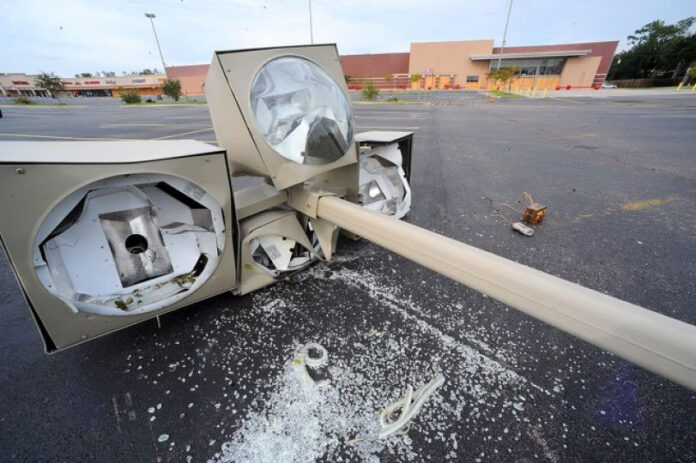It can get windy out there no matter where you are, but it can get especially gusty in coastal Florida and other similar high-wind zones. If you have pole-mounted fixtures lighting your parking lot, tennis court, or even just your backyard, things can get pretty interesting in areas like those during hurricane season.
Whenever Mother Nature gets herself all riled up and throws a major storm in our direction, the media serves up almost endless images of light poles swaying in the wind along with the inevitable examples of a few that couldn’t take the stress and toppled over onto some car’s windshield or ended up strewn across an outdoor tennis or basketball court. At times like these, it’s hard not to worry if your light poles are going to stay up or, instead, be turned into deadly, wind-blown debris. At the very least, you’re always going to wonder how much it’s going to cost to replace whatever gets blown down.
Pole-mounted fixtures have definite advantages. They are bright, require very low maintenance, and operate cost-efficiently. As such, they are an ideal solution for outdoor sports lighting and similar applications. However, this type of installation has an inherent structural challenge; it’s unbelievably top-heavy. Mounting one or more large, heavy, cast-metal fixtures on top of a slender pole, and doing so in an area known for its high winds, can easily turn into a recipe for disaster if the wrong pole is specified.
Many companies that sell light poles insist that the ones they recommend for use in low-wind applications are also capable of coping with higher-velocity wind zones. In fact, this is rarely true. Quite often, a pole will be able to withstand certain wind stresses, but that may not take into consideration the fixture(s) installed on top. Let’s face it, a 4”x4” 7-gauge steel pole with two 70-pound fixtures mounted on top probably won’t stand a chance when things get breezy in coastal South Carolina.
Dan Rodriguez, Sales Manager for Worcester, MA-based Access Fixtures says his company offers multiple solutions to this problem. “Quite a few of our customers have installations in zones where Class V hurricanes are a frequent occurrence,” he said. “For applications like this, we strongly recommend a much more robust structure. Typically, our customers will choose a 5”x5” 7-gauge pole for virtually all high-wind applications, but for areas with the most savage, sustained winds, we also offer a standard 6”x6” 7-gauge as well as poles custom built to any size or specification.”
While selecting a larger, more robust pole may incur a small price premium when compared to purchasing the smaller, weaker 4”x4” variety, the stronger, more durable pole will protect your investment and – most importantly – ensure your installation meets local code.
Rodriguez commented, “Before purchasing pole-mounted fixtures for high-wind zones, it is important to identify their Effective Projected Area; what we in the lighting industry refer to as EPA. The EPA of a fixture is equal to the area exposed to direct wind from a particular angle. All pole-mounted fixtures and mounting hardware have EPA ratings. Obviously, the total EPA and the weight mounted on any pole must not exceed the pole’s maximum rating for the wind zone in which it is located.”
The moral of this story: Pay close attention to your local codes, and strongly consider building in a little extra buffer to ensure your fixtures stay up in the air where they belong rather than succumbing to the powerful combination of strong winds and gravity.



